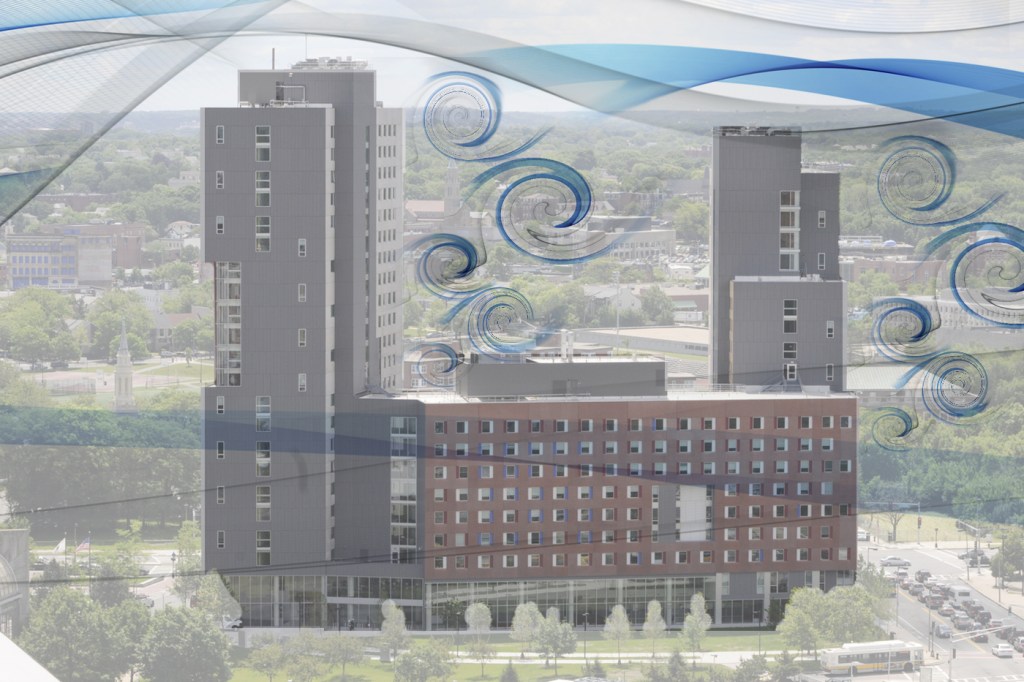World’s wind engineering experts convene at Northeastern

June 1 marked the official start of the 2016 Atlantic hurricane season, but Hurricane Alex and Tropical Storm Bonnie couldn’t wait: Alex hit early in January, and Bonnie followed in May.
Luca Caracoglia, associate professor in the Department of Civil and Environmental Engineering, knows the havoc such high winds and crashing rain can wreak on tall buildings, bridges, chimneys, and other non-streamlined, or “bluff,” bodies.
Last week, he brought his expertise in structural dynamics and wind engineering to bear as chairman and co-host of the Eighth International Colloquium on Bluff Body Aerodynamics and Applications. Over four days, more than 200 engineering experts from around the world convened at Northeastern to discuss how to best analyze and structure these square, circular, and oblong bodies to withstand turbulent airflows and respond with more resilience to structural oscillations and vibrations, among other topics.. Chris Letchford, professor at Rensselaer Polytechnic Institute and president of the American Association for Wind Engineering (AAWE), served as co-chairman.
Whitecaps in the air
“A bluff body, when immersed in an airflow, experiences a wake and a recirculation region forms behind it,” explains Caracoglia, who specializes in several areas, including tall buildings, the wind-induced dynamic instability of long-span bridge decks and wind-turbine blades, and stay-cable aerodynamics and vibration.
Picture the recirculating whitecaps behind a ship coursing through the water, but here it’s whipped air interacting with a building like Boston’s 200 Clarendon—formerly John Hancock Tower—whose windows hurtled to the street during high winds in the 1970s, or the Tacoma Narrows Bridge, in Washington state, which collapsed due to wind-induced vibrations in 1940. Construction workers, observing the bridge’s vertical looping before the collapse, dubbed it “Galloping Gertie.”

Luca Caracoglia, associate professor, delivers opening remarks at the international colloquium. Photo by Matthew Modoono/Northeastern University
“It’s a structure’s shape that determines its response to severe winds,” says Caracoglia. Bluff bodies, with their corners, edges, and spread, are particularly vulnerable to wind velocity fluctuations. “Broadly, in our research we are investigating what characteristics to change to reduce the vibrations and other responses that can make these structures unsafe.”
In particular, Caracoglia focuses on developing numerical methodologies to simulate how tall buildings will respond to high winds. The aim is to provide engineers and designers with the means to determine which specifications respond best as they plan to construct and renovate the structures.
In a recent paper, he and doctoral candidate Wei Cui outlined a methodology that went beyond analyzing the structural performance of tall buildings in hurricane conditions to assess the lifetime costs, including repairs and maintenance, such buildings would sustain because of damage from the winds. Focusing on the Atlantic coastline, the researchers considered how climate warming over time would affect hurricane frequency and intensity to calculate future wind speeds in the area. They used a 180-meter tall building in Miami as a benchmark, and confirmed that the methodology was transferrable by running simulations using variables from several other cities along the Atlantic coastline.
“We wanted to assess how the maintenance cost, consequent to damage from strong storms, can accumulate over time,” says Caracoglia. “Eventually this methodology can be used to infer how to make the most cost-efficient decisions regarding design for future tall buildings in areas likely to be hit by hurricanes and other severe weather.”
The colloquium
The colloquium, which was attended by experienced researchers and talented graduate students, comprised a blend of fundamental work and practical applications and addressed both computational and wind-tunnel studies.
It is held every four years under the umbrella of the International Association for Wind Engineering (IAWE). The IAWE, AAWE, and several industry sponsors provided funds to support the travel of more than 30 students who attended the colloquium and presented their work.





